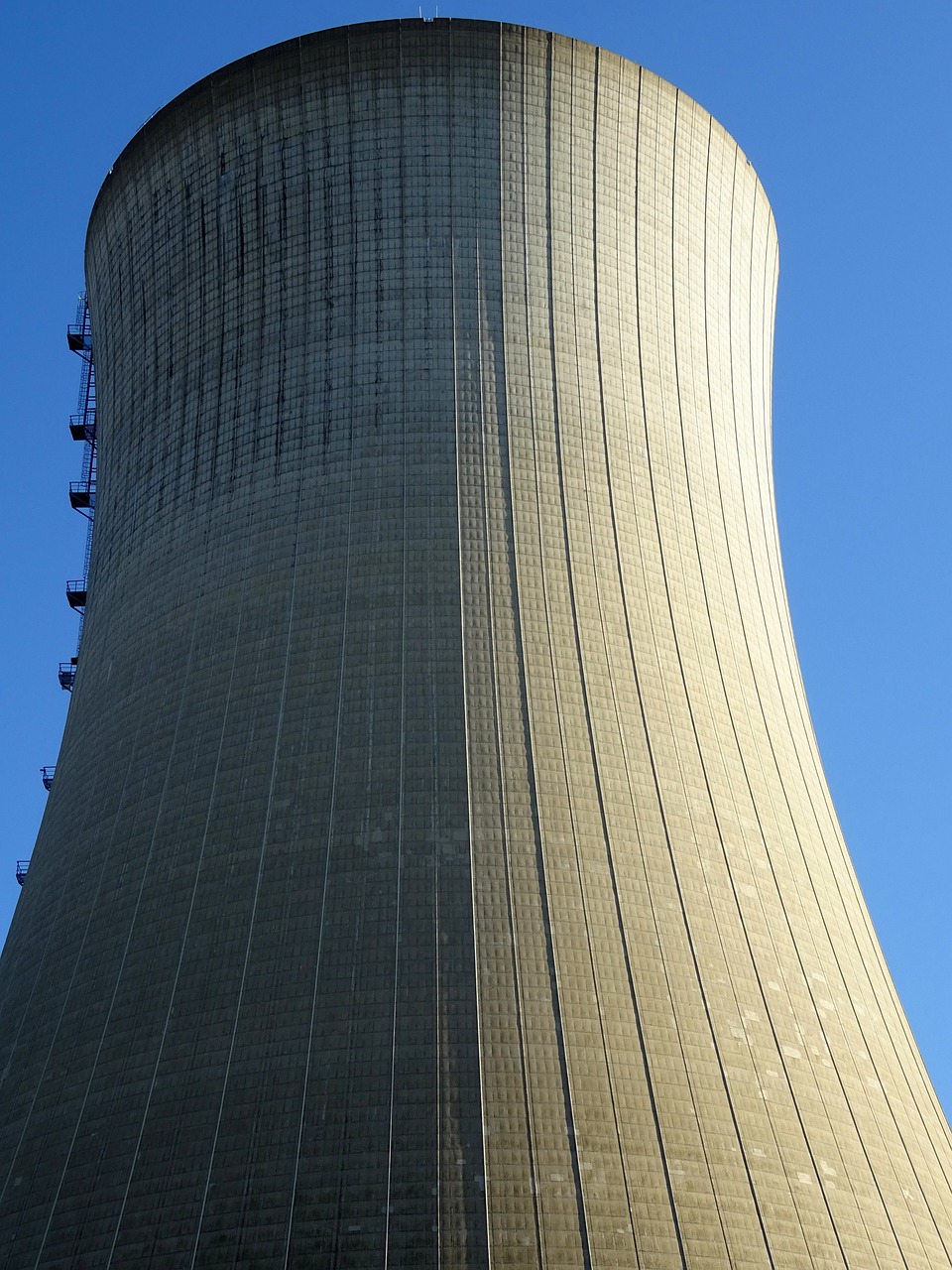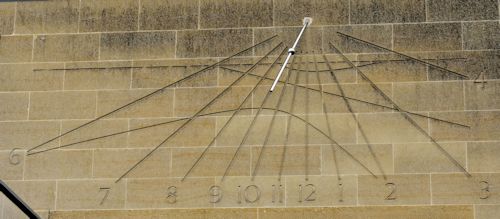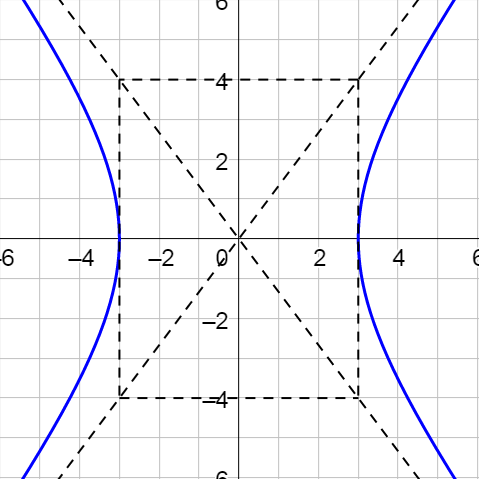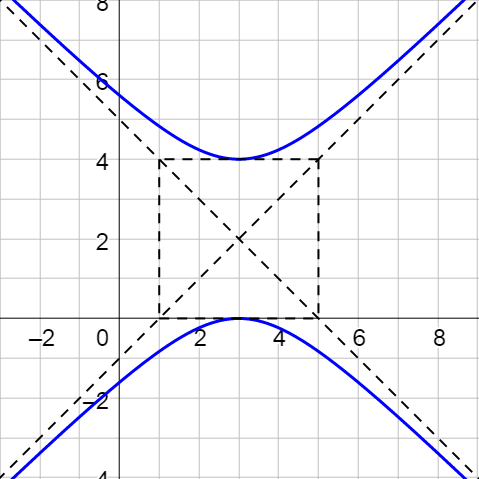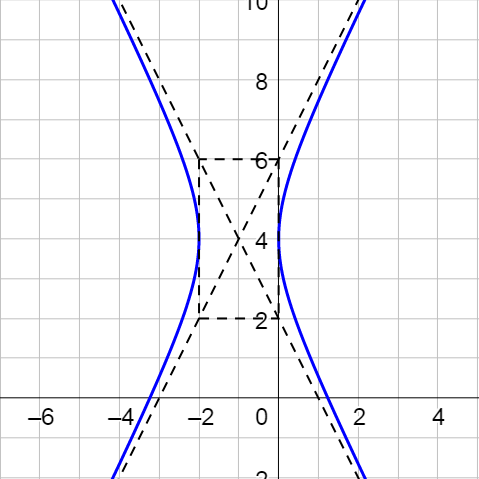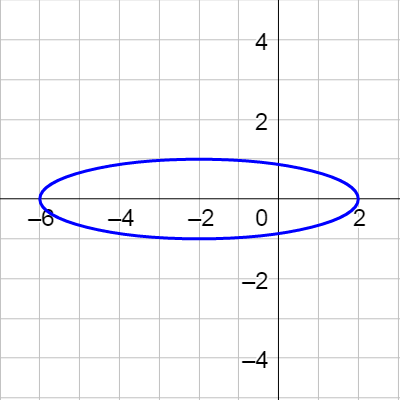Precalculus by Richard Wright
Precalculus by Richard Wright
And surely I am with you always, to the very end of the age. Matthew 28:20b NIV
Summary: In this section, you will:
SDA NAD Content Standards (2018): PC.6.7

When designing cooling towers for power plants, engineers needed to find a shape that withstands high winds and is built with as little material as possible. A hyperbolic shape solves both problems. In addition, the shape helps the cooling air naturally rise.
Hyperbolas are the set of all points in a plane where the difference of the distances from two set points, foci, is constant. In figure 2, d1 – d2 is constant.
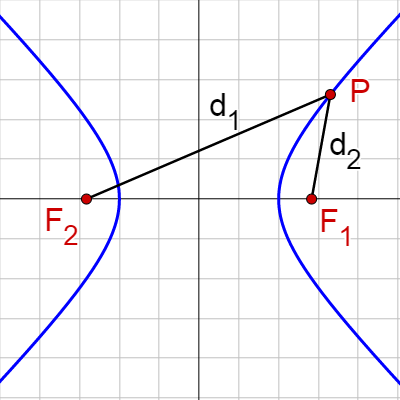
The vertices are the minimum/maximum of each branch of the hyperbola. The covertices are analogous to the covertices of the ellipse, but are not actually on the hyperbola. The transverse axis is the segment connecting the vertices, and the conjugate axis is the segment connecting the covertices. A box with the vertices and covertices as midpoints of the sides provides an aid for sketching the graph of the hyperbola. The branches are asymptotic with the asymptotes going through the corners of the box.
Horizontal Hyperbola |
Vertical Hyperbola |
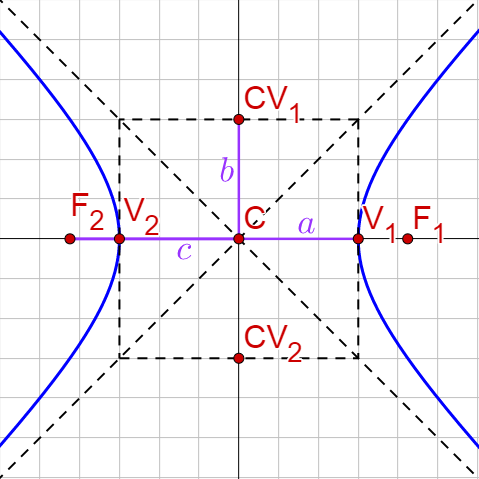 |
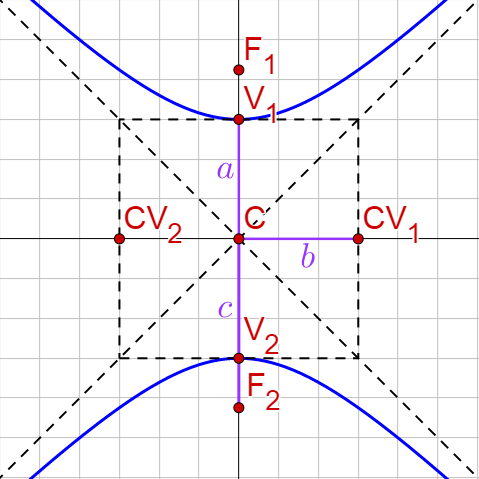 |
| Center: (h, k) Horizontal transverse axis length = 2a Vertical conjugate axis length = 2b c2 = a2 + b2 Vertices: (h ± a, k) Covertices: (h, k ± b) Foci: (h ± c, k) Asymptotes: \(y = k ± \frac{b}{a}(x - h)\) Standard Equation: \(\frac{\left(x - h\right)^2}{a^2} - \frac{\left(y - k\right)^2}{b^2} = 1\) |
Center at (h, k) Vertical transverse axis length = 2a Horizontal conjugate axis length = 2b c2 = a2 + b2 Vertices (h, k ± a) Covertices (h ± b, k) Foci (h, k ± c) Asymptotes: \(y = k ± \frac{a}{b}(x - h)\) Standard Equation: \(\frac{\left(y - k\right)^2}{a^2} - \frac{\left(x - h\right)^2}{b^2} = 1\) |
Eccentricity is \(e = \frac{c}{a}\) where e > 1. The larger the eccentricity is, the closer the branches are to straight lines.
Find the center, vertices, asymptotes, and foci of the hyperbola given by 16x2 − 4y2 = 64.
Solution
Write the equation in standard form by dividing by 64 so that the equation equals 1.
$$\frac{x^2}{4} - \frac{y^2}{16} = 1$$
Because x comes first, this is a horizontal hyperbola. Compare this equation with the standard form, \(\frac{\left(x - h\right)^2}{a^2} - \frac{\left(y - k\right)^2}{b^2} = 1\), to see that h = 0, k = 0, a2 = 9 so a = 3, and b2 = 4 so b = 2.
c2 = a2 + b2
c2 = 4 + 16 = 20
$$c = 2\sqrt{5}$$
Center is (0, 0).
Vertices are (±2, 0).
Covertices are (0, ±4).
Asymptotes are y = ±2x.
Foci are (\(±2\sqrt{5}\), 0).
Find the center, vertices, covertices, asymptotes, and foci of \(\frac{(y - 2)^2}{36} - \frac{(x + 5)^2}{49} = 1\).
Answer
C(−5, 2), V(−5, −4) and (−5, 8), CV(−12, 2) and (2, 2), Asymptotes: \(y = 2 ± \frac{6}{7}(x + 5)\), F(-5, 2 ± \(\sqrt{85}\))
Find the standard form of the equation of the hyperbola centered at (−3, 1) with transverse axis length 6 and foci at (−3, −4) and (−3, 6). Then graph the hyperbola.
Solution
Graphing the three points shows that the transverse axis is vertical.
The transverse axis length is 2a = 6, so a = 3.
The distance from the center to the foci is c, so c = 5.
Find b
c2 = a2 + b2
52 = 32 + b2
b2 = 16
b = 4
The center is (−3, 1) so h = −3 and k = 1.
Write the standard form equation for a vertical hyperbola.
$$\frac{(y - 1)^2}{9} - \frac{(x + 3)^2}{16} = 1$$
Graph it by plotting the center.
Given that it is a vertical ellipse, move the distance a = 5 vertically from the center and a distance b = 4 horizontally from the center.
Draw a rectangle with these four points as the center of each side.
Draw diagonal lines through the corners of the rectangle. These are the asymptotes.
Sketch the hyperbola starting near an asymptote, curving through the vertex, and ending near the other asymptote.
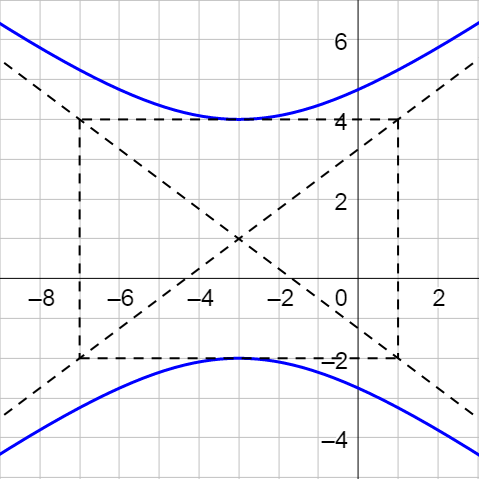
Find the standard form of the equation of the hyperbola with vertices at (1, 5) and (1, -3) and foci at (1, 7) and (1, -5). Then graph the hyperbola.
Answer
\(\frac{(y - 1)^2}{16} - \frac{(x - 1)^2}{20} = 1\), 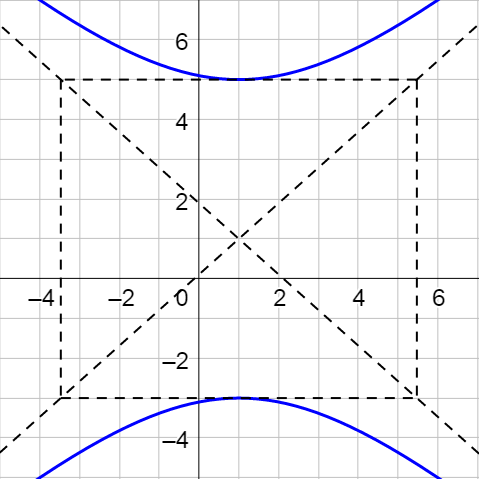
Sketch the graph of the hyperbola given by 9x2 − 25y2 + 18x + 50y − 191 = 0.
Solution
Write the equation in standard form by completing the square. Start by moving the constant to the other side and factoring the x’s and y’s.
9(x2 + 2x) − 25(y2 − 2y) = 191
Add \(\left(\frac{1}{2} b\right)^2\) for both the x’s and y’s. On the right side, don’t forget to multiply by the coefficient.
$$9\left(x^2 + 2x + \left(\frac{1}{2} \left(2\right)\right)^2\right) - 25\left(y^2 - 2y + \left(\frac{1}{2}\left(-2\right)\right)^2\right) = 191 + 9\left(\frac{1}{2}\left(2\right)\right)^2 - 25\left(\frac{1}{2}\left(-2\right)\right)^2$$
9(x2 + 2x + 1) − 25(y2 − 2y + 1) = 191 + 9 − 25
Factor the left side.
9(x + 1)2 − 25(y − 1)2 = 175
Divide both sides by 175.
$$\frac{(x + 1)^2}{25} - \frac{(y - 1)^2}{9} = 1$$
This is a horizontal hyperbola.
The center is at (−1, 1), a = 5 and b = 3.
Go horizontally a = 5 from the center and vertically b = 3 from the center. These four points form the box. Draw the diagonals and then the hyperbola.
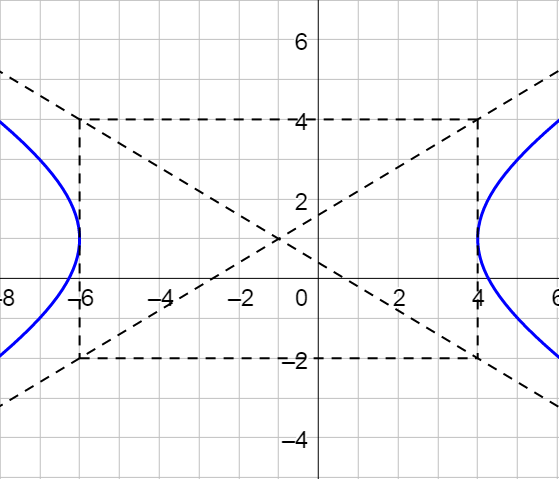
Sketch the graph of the hyperbola given by x2 − 4y2 + 4x = 0.
Answer
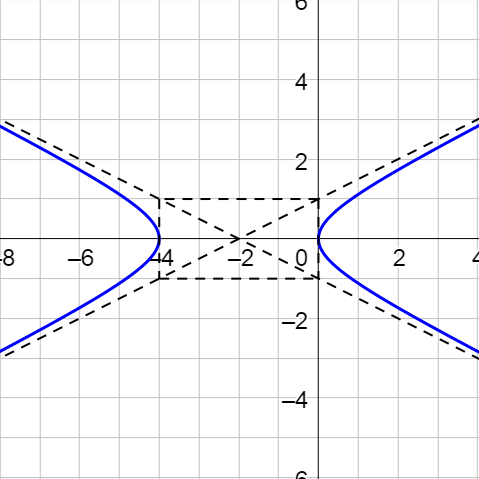
All vertical and horizontal conics can be written in this general form.
Ax2 + Cy2 + Dx + Ey + F = 0
The conics can be classified by the following.
If a conic is written in general form: Ax2 + Cy2 + Dx + Ey + F = 0
Classify each conic.
Solution
Compare each equation to the general equation of a conic, Ax2 + Cy2 + Dx + Ey + F = 0, and find A and C. A is the coefficient of the x2 term and C is the coefficient of the y2 term.
Classify each conic.
Answer
(a) Ellipse; (b) Parabola
Horizontal Hyperbola |
Vertical Hyperbola |
 |
 |
| Center: (h, k) Horizontal transverse axis length = 2a Vertical conjugate axis length = 2b c2 = a2 + b2 Vertices: (h ± a, k) Covertices: (h, k ± b) Foci: (h ± c, k) Asymptotes: \(y = k ± \frac{b}{a}(x - h)\) Standard Equation: \(\frac{\left(x - h\right)^2}{a^2} - \frac{\left(y - k\right)^2}{b^2} = 1\) |
Center at (h, k) Vertical transverse axis length = 2a Horizontal conjugate axis length = 2b c2 = a2 + b2 Vertices (h, k ± a) Covertices (h ± b, k) Foci (h, k ± c) Asymptotes: \(y = k ± \frac{a}{b}(x - h)\) Standard Equation: \(\frac{\left(y - k\right)^2}{a^2} - \frac{\left(x - h\right)^2}{b^2} = 1\) |
If a conic is written in general form: Ax2 + Cy2 + Dx + Ey + F = 0
Helpful videos about this lesson.
